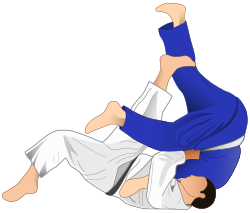Sumi gaeshi
| Sumi gaeshi | |
|---|---|
 Vector illustration of Sumi-gaeshi technique. | |
| Classification | Nage-waza |
| Sub classification | Sutemi-waza |
| Kodokan | Yes |
| Technique name | |
| Rōmaji | Sumi gaeshi |
| Japanese | 隅返 |
| English | Corner reversal |
Template:Contains Japanese text
Sumi Gaeshi (隅返) is one of the original 40 throws of Judo as developed by Jigoro Kano. It belongs to the fourth group, Dai Yonkyo, of the traditional throwing list, Gokyo-no-Nagewaza, of Kodokan Judo. It is also part of the current 67 Throws of Kodokan Judo. It is classified as a rear sacrifice technique, Sutemi-waza.
Technique Description
The Sumi Gaeshi is done by grabbing your uke opposite you by their clothing, more specifically below the collar. The tori then plants their foot or knee in the opposite upper thigh, taking care not to hit the groin. The user then rolls backwards using the forward momentum of the opponent to propel them forward. This can be followed up with any number of grapples, joint extensions, or choke holds.
Technique History
This section is empty. You can help by adding to it. (July 2010) |
Included Systems
Systems:
Lists:
Similar Techniques, Variants, and Aliases
English aliases:
- Corner throw
- Corner reversal
